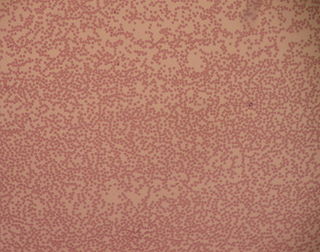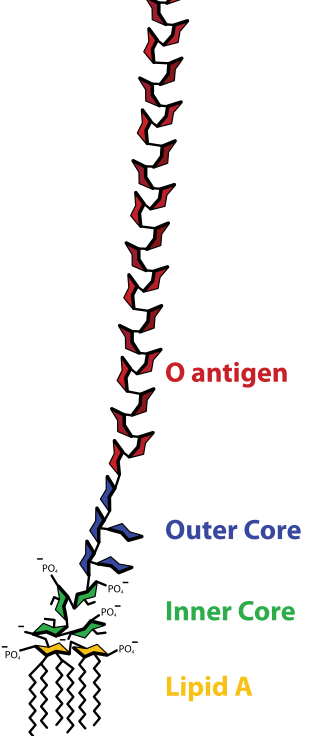Related Research Articles

Lemierre's syndrome is infectious thrombophlebitis of the internal jugular vein. It most often develops as a complication of a bacterial sore throat infection in young, otherwise healthy adults. The thrombophlebitis is a serious condition and may lead to further systemic complications such as bacteria in the blood or septic emboli.

Sepsis is a potentially life-threatening condition that arises when the body's response to infection causes injury to its own tissues and organs.

Neutropenia is an abnormally low concentration of neutrophils in the blood. Neutrophils make up the majority of circulating white blood cells and serve as the primary defense against infections by destroying bacteria, bacterial fragments and immunoglobulin-bound viruses in the blood. People with neutropenia are more susceptible to bacterial infections and, without prompt medical attention, the condition may become life-threatening.

Lipopolysaccharide, now more commonly known as Endotoxin, is a collective term for components of the outermost membrane of cell envelope of Gram-negative bacteria, such as E. coli and Salmonella. with a common structural architecture. Lipopolysaccharides (LPS) are large molecules consisting of 3 parts: an outer core polysaccharide termed the O-antigen, an inner core oligosaccharide and Lipid A, all covalently linked. In current terminology, the term endotoxin is often used synonymously with LPS, although there are a few endotoxins that are not related to LPS, such as the so-called delta endotoxin proteins produced by Bacillus thuringiensis.

Septic shock is a potentially fatal medical condition that occurs when sepsis, which is organ injury or damage in response to infection, leads to dangerously low blood pressure and abnormalities in cellular metabolism. The Third International Consensus Definitions for Sepsis and Septic Shock (Sepsis-3) defines septic shock as a subset of sepsis in which particularly profound circulatory, cellular, and metabolic abnormalities are associated with a greater risk of mortality than with sepsis alone. Patients with septic shock can be clinically identified by requiring a vasopressor to maintain a mean arterial pressure of 65 mm Hg or greater and having serum lactate level greater than 2 mmol/L (>18 mg/dL) in the absence of hypovolemia. This combination is associated with hospital mortality rates greater than 40%.
In immunology, cytokine release syndrome (CRS) is a form of systemic inflammatory response syndrome (SIRS) that can be triggered by a variety of factors such as infections and certain drugs. It refers to cytokine storm syndromes (CSS) and occurs when large numbers of white blood cells are activated and release inflammatory cytokines, which in turn activate yet more white blood cells. CRS is also an adverse effect of some monoclonal antibody medications, as well as adoptive T-cell therapies. When occurring as a result of a medication, it is also known as an infusion reaction.

Doxycycline is a broad-spectrum antibiotic of the tetracycline class used in the treatment of infections caused by bacteria and certain parasites. It is used to treat bacterial pneumonia, acne, chlamydia infections, Lyme disease, cholera, typhus, and syphilis. It is also used to prevent malaria. Doxycycline may be taken by mouth or by injection into a vein.

Azithromycin, sold under the brand names Zithromax and Azasite, is an antibiotic medication used for the treatment of a number of bacterial infections. This includes middle ear infections, strep throat, pneumonia, traveler's diarrhea, and certain other intestinal infections. Along with other medications, it may also be used for malaria. It is administered by mouth, into a vein, or into the eye.

Procalcitonin (PCT) is a peptide precursor of the hormone calcitonin, the latter being involved with calcium homeostasis. It arises once preprocalcitonin is cleaved by endopeptidase. It was first identified by Leonard J. Deftos and Bernard A. Roos in the 1970s. It is composed of 116 amino acids and is produced by parafollicular cells of the thyroid and by the neuroendocrine cells of the lung and the intestine.

Amphotericin B is an antifungal medication used for serious fungal infections and leishmaniasis. The fungal infections it is used to treat include mucormycosis, aspergillosis, blastomycosis, candidiasis, coccidioidomycosis, and cryptococcosis. For certain infections it is given with flucytosine. It is typically given intravenously.
In immunology, systemic inflammatory response syndrome (SIRS) is an inflammatory state affecting the whole body. It is the body's response to an infectious or noninfectious insult. Although the definition of SIRS refers to it as an "inflammatory" response, it actually has pro- and anti-inflammatory components.
Multiple organ dysfunction syndrome (MODS) is altered organ function in an acutely ill patient requiring medical intervention to achieve homeostasis. Although Irwin and Rippe cautioned in 2005 that the use of "multiple organ failure" or "multisystem organ failure" should be avoided, both Harrison's (2015) and Cecil's (2012) medical textbooks still use the terms "multi-organ failure" and "multiple organ failure" in several chapters and do not use "multiple organ dysfunction syndrome" at all.

Granulocyte-macrophage colony-stimulating factor (GM-CSF), also known as colony-stimulating factor 2 (CSF2), is a monomeric glycoprotein secreted by macrophages, T cells, mast cells, natural killer cells, endothelial cells and fibroblasts that functions as a cytokine. The pharmaceutical analogs of naturally occurring GM-CSF are called sargramostim and molgramostim.
A cytokine storm, also called hypercytokinemia, is a pathological reaction in humans and other animals in which the innate immune system causes an uncontrolled and excessive release of pro-inflammatory signaling molecules called cytokines. Cytokines are a normal part of the body's immune response to infection, but their sudden release in large quantities may cause multisystem organ failure and death.

Rifaximin, is a non-absorbable, broad spectrum antibiotic mainly used to treat travelers' diarrhea. It is based on the rifamycin antibiotics family. Since its approval in Italy in 1987, it has been licensed in over more than 30 countries for the treatment of a variety of gastrointestinal diseases like irritable bowel syndrome, and hepatic encephalopathy. It acts by inhibiting RNA synthesis in susceptible bacteria by binding to the RNA polymerase enzyme. This binding blocks translocation, which stops transcription. It is marketed under the brand name Xifaxan by Salix Pharmaceuticals.

A Jarisch–Herxheimer reaction is a sudden and typically transient reaction that may occur within 24 hours of being administered antibiotics for an infection by a spirochete, including syphilis, leptospirosis, Lyme disease, and relapsing fever. Signs and symptoms include fever, chills, shivers, feeling sick, headache, fast heart beat, low blood pressure, breathing fast, flushing of skin, muscle aches, and worsening of skin lesions. It may sometimes be mistaken as an allergy to the antibiotic.

Polymyxin B, sold under the brand name Poly-Rx among others, is an antibiotic used to treat meningitis, pneumonia, sepsis, and urinary tract infections. While it is useful for many Gram negative infections, it is not useful for Gram positive infections. It can be given by injection into a vein, muscle, or cerebrospinal fluid or inhaled. The injectable form is generally only used if other options are not available. It is also available as the combinations bacitracin/polymyxin B and neomycin/polymyxin B/bacitracin for use on the skin.
Capillary leak syndrome, or vascular leak syndrome, is characterized by the escape of blood plasma through capillary walls, from the blood circulatory system to surrounding tissues, muscle compartments, organs or body cavities. It is a phenomenon most commonly witnessed in sepsis, and less frequently in autoimmune diseases, differentiation syndrome, engraftment syndrome, hemophagocytic lymphohistiocytosis, the ovarian hyperstimulation syndrome, viral hemorrhagic fevers, and snakebite and ricin poisoning. Pharmaceuticals, including the chemotherapy medications gemcitabine and denileukin diftitox, as well as certain interleukins and monoclonal antibodies, can also cause capillary leaks. These conditions and factors are sources of secondary capillary leak syndrome.
Febrile neutropenia is the development of fever, often with other signs of infection, in a patient with neutropenia, an abnormally low number of neutrophil granulocytes in the blood. It is an oncologic emergency, and is the most common serious complication in patients with hematopoietic cancers or receiving chemotherapy for cancer. The term neutropenic sepsis is also applied, although it tends to be reserved for patients who are less well. In 50% of cases, an infection is detectable; bacteremia is present in approximately 20% of all patients with this condition.
CytoSorbents Corporation is a publicly traded company located in Princeton, New Jersey.
References
- 1 2 3 Honore, PM; Jacobs, R; Joannes-Boyau, O; De Regt, J; De Waele, E; van Gorp, V; Boer, W; Verfaillie, L; Spapen, HD (2013). "Newly designed CRRT membranes for sepsis and SIRS--a pragmatic approach for bedside intensivists summarizing the more recent advances: a systematic structured review". ASAIO Journal. 59 (2): 99–106. doi: 10.1097/mat.0b013e3182816a75 . PMID 23438770. S2CID 21246431.
- 1 2 "This Cartridge of Plastic Beads Can Filter Blood During Surgery". Bloomberg. 10 September 2018. Retrieved 2018-09-10.
- ↑ Berlot, Giorgio; Di Bella, Stefano; Tomasini, Ariella; Roman-Pognuz, Erik (2022-01-29). "The Effects of Hemoadsorption on the Kinetics of Antibacterial and Antifungal Agents". Antibiotics. 11 (2): 180. doi: 10.3390/antibiotics11020180 . hdl: 11368/3007260 . ISSN 2079-6382. PMC 8868360 . PMID 35203783.
- ↑ "Biotech Product Geared Toward Reducing Deaths in the ICU". Sentinel. Archived from the original on 7 June 2014. Retrieved 9 April 2014.
- ↑ "Extracorporeal Therapy for the Removal of Myoglobin Using the CytoSorb in Patients With Rhabdomyolysis". clinicaltrials.gov. Retrieved 6 May 2014.